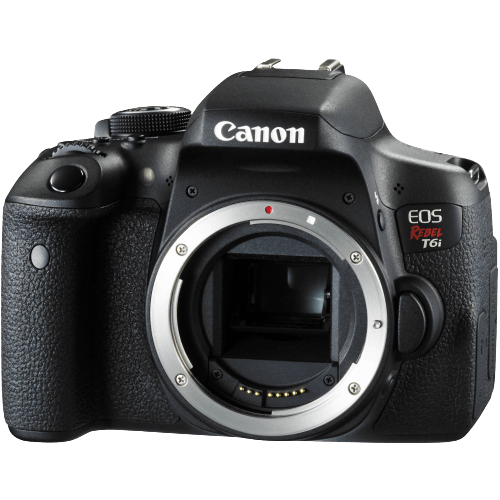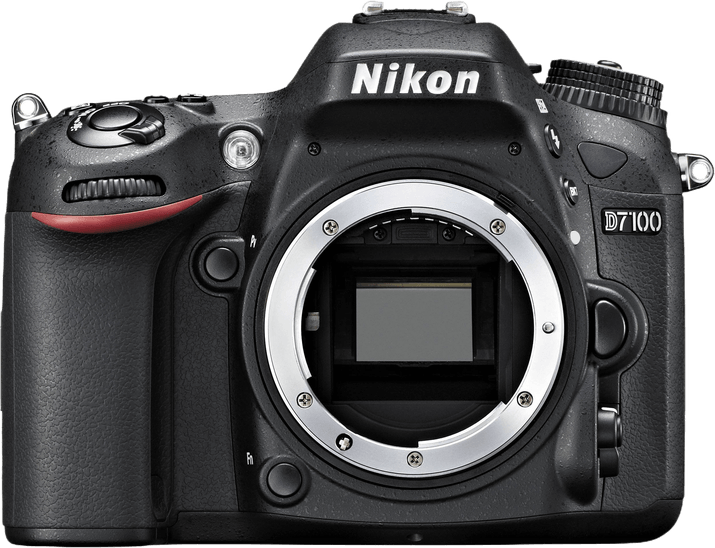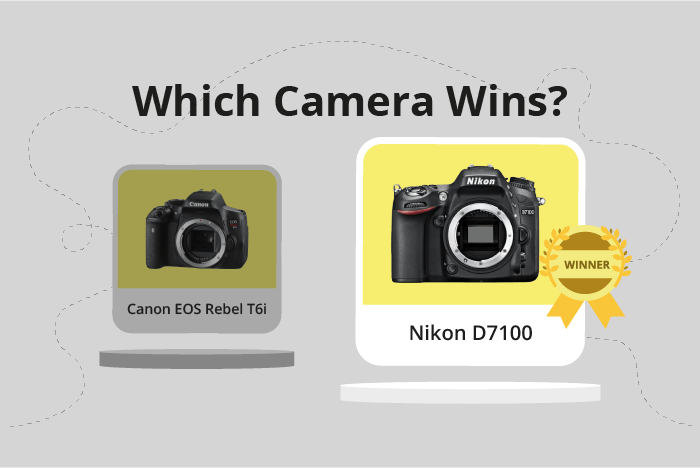Canon EOS Rebel T6i / 750D vs Nikon D7100 Comparison
Canon EOS Rebel T6i / 750D

Nikon D7100

The Nikon D7100 outperforms the Canon EOS Rebel T6i / 750D with a score of 65/100 versus 56/100. Both cameras are DSLRs, released in 2013 and 2015 respectively. They share similarities in size, with the Nikon D7100 measuring 136 x 107 x 76mm and the Canon T6i at 132 x 101 x 78mm. However, the Nikon is heavier at 765g compared to the Canon’s 555g.
The Nikon D7100 excels with its higher score, possibly due to factors such as better overall performance or additional features. On the other hand, the Canon T6i may have some advantages, like a lower launch price ($750) compared to the Nikon’s $1200.
Taking all factors into consideration, the Nikon D7100 stands out as the better camera due to its higher score. However, the Canon T6i could still be a viable option for those on a budget or seeking a lighter camera.
Canon EOS Rebel T6i / 750D vs Nikon D7100 Overview and Optics
The Nikon D7100 outperforms the Canon EOS Rebel T6i / 750D in optics, scoring 67/100 compared to the Canon’s 59/100. Both cameras share common specifications, such as 24.1 and 24.2 megapixels, CMOS sensor type, APS-C sensor size, and the absence of image stabilization. Additionally, both cameras use a proprietary lens mount, with the Canon using the EF-S mount and the Nikon using the F DX mount.
The Nikon D7100 excels in several areas, contributing to its higher score. It has a faster shooting speed of 6 frames per second (fps) compared to the Canon’s 5 fps. Moreover, the D7100 has a significantly better DXOMARK sensor score of 83, while the Canon T6i has a score of 71. This difference indicates that the Nikon D7100 captures images with better overall quality, dynamic range, and low-light performance.
On the other hand, the Canon T6i has a slightly higher megapixel count at 24.2 compared to the Nikon’s 24.1. However, this small difference is unlikely to have a significant impact on image quality. The Canon also has a more advanced image processor, the Digic 6, compared to Nikon’s Expeed 3. This may result in faster image processing and better overall performance, but it does not necessarily translate to better optics.
In terms of optics, the Nikon D7100 is the superior camera due to its faster shooting speed and better DXOMARK sensor score. The Canon T6i has minor advantages in megapixels and image processing, but they do not outweigh the benefits of the Nikon’s superior optics.
Canon EOS Rebel T6i / 750D vs Nikon D7100 Video Performance
The Nikon D7100 surpasses the Canon EOS Rebel T6i / 750D in video capabilities with a 14-point advantage, scoring 57/100 compared to the Canon’s 43/100. Both cameras share common specifications, such as Full HD video resolution, maximum video dimensions of 1920 x 1080, and a maximum video frame rate of 30fps. However, the Nikon D7100 outshines the Canon T6i in certain aspects.
The winning feature of the Nikon D7100 is its built-in time-lapse functionality. This allows users to capture stunning time-lapse videos without the need for additional equipment or software. This feature makes the Nikon D7100 a more versatile camera for both amateur and professional videographers alike.
On the other hand, the Canon T6i does not offer any specific advantages in video capabilities over the Nikon D7100. Both cameras have the same basic video specifications, but the Canon T6i lags behind due to its lack of time-lapse functionality.
In comparing the video capabilities of the Canon EOS Rebel T6i / 750D and the Nikon D7100, it is evident that the Nikon D7100 is the superior camera. Its built-in time-lapse functionality sets it apart from the Canon T6i, making it a more versatile choice for those looking to capture high-quality videos. The Canon T6i, while still offering Full HD resolution and a maximum video frame rate of 30fps, falls short in providing additional features to enhance the overall video experience.
Canon EOS Rebel T6i / 750D vs Nikon D7100 Features and Benefits
The Nikon D7100 outperforms the Canon EOS Rebel T6i / 750D in features with a score of 59/100 compared to the Canon’s 57/100. Both cameras share some common specifications, such as a 3-inch screen size, no GPS, WIFI connectivity, and no Bluetooth. However, there are differences that make one camera better than the other in specific aspects.
The Nikon D7100 has a larger 3.2-inch screen and a higher resolution of 1,228,800 dots, providing a clearer and more detailed display than the Canon T6i / 750D’s 1,040,000 dots. This makes the Nikon D7100 better for reviewing images and navigating menus. However, the Canon T6i / 750D has a touchscreen and a flip screen, which allows for easier navigation and greater flexibility when composing shots, especially in difficult angles or for self-portraits. This is an advantage the Nikon D7100 lacks.
The Canon T6i / 750D’s touchscreen and flip screen features may be beneficial to some users, but the Nikon D7100’s larger screen and higher resolution offer a better display experience. Both cameras lack GPS and Bluetooth but offer WIFI connectivity, ensuring that users can transfer images and control the camera remotely.
Therefore, the Nikon D7100 is the winner in this comparison due to its superior screen size and resolution, despite the Canon T6i / 750D’s additional touchscreen and flip screen features. Users should consider their specific needs and preferences when choosing between these two cameras, as each has its unique advantages.
Canon EOS Rebel T6i / 750D vs Nikon D7100 Storage and Battery
The Nikon D7100 outperforms the Canon EOS Rebel T6i / 750D in storage and battery with a score of 76/100 compared to the Canon’s 24/100. Both cameras share some common specifications, such as accepting SD, SDHC, and SDXC memory cards and lacking USB charging capabilities.
The Nikon D7100 surpasses the Canon T6i with its dual memory card slots and an impressive battery life of 950 shots, using the EN-EL15 battery type. These features make the Nikon D7100 more versatile and reliable for extended shooting sessions or when backup storage is necessary.
On the other hand, the Canon T6i has only one memory card slot and a shorter battery life of 440 shots, using the LP-E17 battery type. While this is inferior to the Nikon D7100’s performance, it may still be sufficient for casual photographers or those who do not require extensive storage and battery life.
Considering these factors, the Nikon D7100 offers superior storage and battery capabilities, making it a better choice for photographers who prioritize these aspects. The Canon T6i may be adequate for some users, but its limitations in this area should be considered when making a decision.
Alternatives to the Canon EOS Rebel T6i / 750D and Nikon D7100
Are you still undecided about which camera is right for you? Have a look at these popular comparisons that feature the Canon EOS Rebel T6i / 750D or the Nikon D7100:

